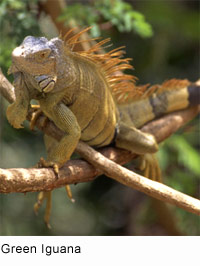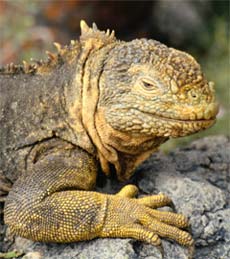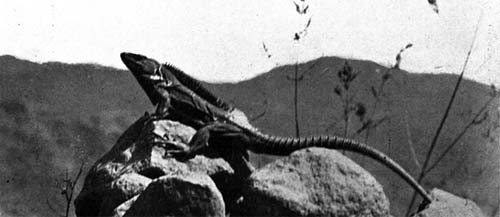
 The Green iguana (Iguana iguana) is a large, arboreal lizard from Central and South America. The Green iguana is found over a large geographic area, from Mexico to southern Brazil and Paraguay, as well as on the Caribbean Islands. They are typically about 2 meters in length from head to tail and can weigh up to 5 kg. The Green iguana (Iguana iguana) is a large, arboreal lizard from Central and South America. The Green iguana is found over a large geographic area, from Mexico to southern Brazil and Paraguay, as well as on the Caribbean Islands. They are typically about 2 meters in length from head to tail and can weigh up to 5 kg.
Tell All Legs: It is possible to determine the sex of a Green iguana by examining the underside of the hind legs. Males have highly developed pores in this area that secrete scent, and are often covered in a waxy substance. In addition, the spiny scales that run along an iguana's back are noticeably longer and thicker in males than they are in females.
Just the Facts: Green iguanas are diurnal and strictly herbivorous, feeding on leaves, flowers, fruit, and growing shoots (although the young were once thought to eat insects, this has been proven false), and can be found living in trees and near water, into which they will dive if frightened. Agile climbers, they can fall up to 40 feet without being injured, and can run quickly despite their clumsy appearance. Because of their popularity in the pet trade and as food in Latin American countries, green iguanas are listed on the CITES Appendix II, which means they are considered a threatened species.
 When in Danger... When threatened by a potential predator, green iguanas will do a number of things. First and foremost, they will flee. If near a water source, they will dive into the water and swim off. When in Danger... When threatened by a potential predator, green iguanas will do a number of things. First and foremost, they will flee. If near a water source, they will dive into the water and swim off.
Secondly, they will display the dewlap under their head, puff up their bodies, and display elaborate head-bobbing to the perceived threat.
Finally, if all else fails, they will deliver a bite or lash its tail to the threatening creature. In the case of humans, a bite from an adult iguana can mean a trip to a hospital for stitches.
Popular Pets: These lizards have recently become extremely popular in the pet trade—over 800,000 animals were imported into the United States alone during 1995, mainly coming from captive farming operations based in the country of origin.

Poor Pets: Despite the apparent "mass market" appeal of these animals, however, they are very demanding to care for properly over their lifetime, and the great majority will die within a few short years. Many ignorant buyers are tempted by the price of young iguanas and apparent low cost of feeding, typically giving inappropriate vegetables and insufficient housing without sources of heat. If fed insects, they will eat, if the iguana recognizes the owner. The iguana will be confused and will eat the insect. This might damage the digestive system and the iguana may die. In captivity Green iguanas need to be in temperatures of 75 to 90 degrees Fahrenheit (24 to 32 degrees Celsius) and must have appropriate sources of UVB and UVA lighting. Without proper UVB lighting they can develop metabolic bone disease which can be fatal if not treated.

All text is available under the terms
of the GNU Free Documentation License
|